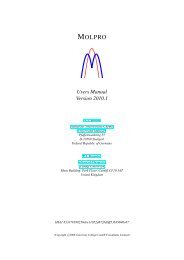Carbon−Carbon Coupling Reactions Catalyzed by Heterogeneous ...
Carbon−Carbon Coupling Reactions Catalyzed by Heterogeneous ...
Carbon−Carbon Coupling Reactions Catalyzed by Heterogeneous ...
You also want an ePaper? Increase the reach of your titles
YUMPU automatically turns print PDFs into web optimized ePapers that Google loves.
<strong>Heterogeneous</strong> Pd <strong>Catalyzed</strong> C−C <strong>Coupling</strong> <strong>Reactions</strong> Chemical Reviews, 2007, Vol. 107, No. 1 153<br />
Table 44. Heck <strong>Reactions</strong> <strong>by</strong> Modified Silica Supported Imine<br />
Palladacycles a<br />
T (°C), conv<br />
entry R, X catalyst solvent t (h) (%)<br />
1 H, I SiO2-IM-Pd-H<br />
(0.2 mol %)<br />
MeCN 82, 24 82<br />
2 H, I SCS-N-pincer DMF 120, 2 93<br />
3 OMe, I Pd-2QC<br />
(0.01 mol %)<br />
NMP 130, 3 98<br />
4 OMe, I Pd-2PC<br />
(0.01 mol %)<br />
NMP 130, 3 99<br />
5 Me, I Pd-2QC<br />
(0.1 mol %)<br />
NMP 130, 1 100<br />
6 Me, I Pd-2PC<br />
(0.1 mol %)<br />
NMP 130, 1 100<br />
7 NO2,Br Pd-2QC<br />
(0.1 mol %)<br />
NMP 130, 1 95<br />
8 NO2,Br Pd-2PC<br />
(0.1 mol %)<br />
NMP 130, 1 90<br />
9 Ac, Br Pd-2QC<br />
(0.1 mol %)<br />
NMP 130, 1 51<br />
10 Ac, Br Pd-2PC<br />
(0.2 mol %)<br />
NMP 130, 1 46<br />
11 H, Br Pd-2QC<br />
(0.2 mol %)<br />
NMP 130, 24 32<br />
12 H, Br Pd-2PC<br />
(0.1 mol %)<br />
NMP 130, 24 30<br />
a Entry 1 is from ref 158; entry 2 from ref 48; others are from ref<br />
159.<br />
Scheme 28. Preparation of Reverse Phase Silica Supported<br />
Palladium Catalysts and Their Application to Heck<br />
<strong>Reactions</strong><br />
yield. This heterogeneous catalyst (SiO2/TEG/Pd) showed<br />
high activity in the Heck coupling reactions of aryl iodides<br />
with styrene (Scheme 29). 120<br />
Scheme 29. SiO2/TEG/Pd-<strong>Catalyzed</strong> Heck Reaction of Aryl<br />
Iodide with Styrene<br />
As another way of fixing Pd to mesoporous silica SBA-<br />
15, SiH groups were introduced <strong>by</strong> reaction with trimethoxysilane,<br />
which reduce Pd(OAc)2. As shown <strong>by</strong> Shi et al., this<br />
procedure results in the deposition of metal colloid layers<br />
on the pore walls, creating one of the most active heterogeneous<br />
catalysts for Heck reactions. 147,161 Excellent yields<br />
were achieved in the coupling of iodo- and bromoarenes with<br />
styrene or methyl acrylate, even when low amounts of<br />
catalyst were used and the coupling was carried out in air<br />
(Scheme 30). The catalyst could easily be separated <strong>by</strong><br />
filtration and reused at least five times without a significant<br />
Scheme 30<br />
loss of activity. Indications for heterogeneity were found,<br />
although small amounts of leached Pd could be detected in<br />
the reaction mixture of the first run.<br />
3.5. Pd on Clay and Other Inorganic Materials<br />
Mg-Al-Layered double hydroxide supported palladium<br />
nanoparticles (LDH-Pd(0)), developed <strong>by</strong> Choudary et al.,<br />
served as versatile catalysts in ligand-free Heck couplings<br />
of various substituted chloroarenes and olefins under nonaqueous<br />
ionic liquid (NAIL) conditions (Table 45). 66 The<br />
reactivity of these chloroarenes is correlated to the electron<br />
density of the aromatic ring. The catalyst was reused for five<br />
cycles in the Heck olefination of 4-chloroanisole with styrene<br />
under microwave and thermal conditions. The higher efficacy,<br />
as displayed in the nonaqueous ionic liquid under<br />
microwave conditions, is ascribed to the ionic conductance.<br />
Table 45. LDH-Pd(0)-<strong>Catalyzed</strong> Heck Olefination of<br />
Chloroarenes under Nonaqueous Ionic Liquid (NAIL)<br />
Conditions<br />
MW (400 W) thermal heating<br />
R1 R2 t (h) yield (%) t (h) yield (%)<br />
H Ph 0.5 95 30 98<br />
NO2 Ph 0.5 96 10 95<br />
Ac Ph 0.5 93 15 97<br />
CHO Ph 0.5 95 15 98<br />
Bz Ph 0.5 91 15 93<br />
OMe<br />
OMe<br />
CO2Bu<br />
Ph<br />
1<br />
1<br />
85<br />
80<br />
40<br />
40<br />
86<br />
76<br />
Me Ph 0.5 92 30 96<br />
CH2OH Ph 0.5 90 30 92<br />
A palladium-containing silicoaluminophosphate-31 (Pd-<br />
SAPO-31) was developed <strong>by</strong> Srinivas, Ratnasamy, et al. as<br />
a highly active catalyst for the Heck reactions of aryl iodides<br />
and chlorides (Scheme 31). 86 The catalyst was found to be<br />
more effective than other solid-supported Pd catalysts (Pd<br />
on carbon, MgO, Al2O3, or graphite). It worked well at<br />
relatively low temperatures (60-120 °C) and allowed<br />
completion of the reactions in short times (about 1.5 h). Pd<br />
leached during the reaction but re-deposited to the solid<br />
support when the reaction had finished. The catalyst could<br />
be recovered <strong>by</strong> simple filtration and reused without a<br />
significant loss of activity or selectivity for a minimum of<br />
three cycles.<br />
Scheme 31. Heck Reaction <strong>Catalyzed</strong> <strong>by</strong> Pd-Containing<br />
Silicoaluminophosphate-31<br />
In an effort to compare the reactivity of LDH-Pd(0) with<br />
those of other heterogeneous catalysts, namely, Pd/C, Pd/<br />
SiO2, resin-Pd(0), and Pd/Al2O3, in the Heck olefination,<br />
corresponding experiments were conducted under identical












![Hetero [6+3] Cycloaddition of Fulvenes with N-Alkylidene Glycine ...](https://img.yumpu.com/35423358/1/190x245/hetero-6-3-cycloaddition-of-fulvenes-with-n-alkylidene-glycine-.jpg?quality=85)




